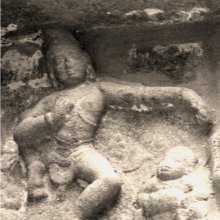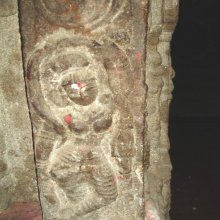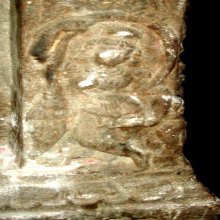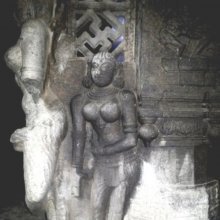Mushti, Muṣṭi: 31 definitions
Introduction:
Mushti means something in Buddhism, Pali, Hinduism, Sanskrit, Jainism, Prakrit, the history of ancient India, Marathi, Hindi, biology, Tamil. If you want to know the exact meaning, history, etymology or English translation of this term then check out the descriptions on this page. Add your comment or reference to a book if you want to contribute to this summary article.
The Sanskrit term Muṣṭi can be transliterated into English as Musti or Mushti, using the IAST transliteration scheme (?).
Images (photo gallery)
(+11 more images available)
In Hinduism
Natyashastra (theatrics and dramaturgy)
Source: Wisdom Library: Nāṭya-śāstraMuṣṭi (मुष्टि, “fist”) refers to a gesture (āṅgika) made with a ‘single hand’ (asaṃyuta), according to the Nāṭyaśāstra chapter 8. The hands (hasta) form a part of the human body which represents one of the six major limbs (aṅga) used in dramatic performance. With these limbs are made the various gestures (āṅgika), which form a part of the histrionic representation (abhinaya).
(Instructions of Muṣṭi): Fingers have their ends [bent] into the palm and the thumb [is set] upon them.
(Uses of Muṣṭi): It is used to represent beating, exercise exit, pressing, shampooing, grasping sword and holding spears and clubs.
Source: archive.org: The mirror of gesture (abhinaya-darpana)One of the Twenty-eight Single Hands (hasta):—Muṣṭi (fist): the four fingers are bent into the palm, and the thumb set on them. Usage: steadiness, grasping the hair, holding things, wrestling.
According to another book: the thumb placed on the middlefinger, and the fingers closed. It originates from Viṣṇnu, whoused this hand when he fought with Madhu. Its sage is Indra,colour indigo, race Śūdra, patron deity the moon. Usage: grasping,waist, fruit, agreement, saying “Very well”, sacrificial offerings,greeting common people, carrying away, strong hold, holding a book, rimning, lightness, wresthng, holding a shield,holding the hair, fisticuffs, grasping a mace or spear, indigocolour, Śūdra caste.
Source: Shodhganga: Elements of Art and Architecture in the Trtiyakhanda of the Visnudharmottarapurana (natya)Muṣṭi (मुष्टि) refers to one of the twenty-two Asaṃyuktahastas or “single hand gestures” (in Indian Dramas), according to the Viṣṇudharmottarapurāṇa, an ancient Sanskrit text which (being encyclopedic in nature) deals with a variety of cultural topics such as arts, architecture, music, grammar and astronomy.—The hasta-mudrās (lit. “hand-gestures”) are very essential to denote some particular action or state in dancing and these mudrās are formed with the help of hands and fingers.—The word muṣṭi denotes the clenched hand. According to the Viṣṇudharmottarapurāṇa, in muṣṭi posture, the fingers are bent towards the palm and the thumb is set on them. This hasta is used in some activities like striking, hard press of the breast, holding sword, stick and spear etc.
In the Abhinayadarpaṇa also, the muṣṭi posture is said to be used in holding things. It speaks that to do the fight with hand this postured is adopted. In the Śabdakalpadruma also, the meaning of the word muṣṭi as a technique of fight has been used.

Natyashastra (नाट्यशास्त्र, nāṭyaśāstra) refers to both the ancient Indian tradition (shastra) of performing arts, (natya—theatrics, drama, dance, music), as well as the name of a Sanskrit work dealing with these subjects. It also teaches the rules for composing Dramatic plays (nataka), construction and performance of Theater, and Poetic works (kavya).
Shilpashastra (iconography)
Source: Shodhganga: The significance of the mūla-beras (śilpa)Muṣṭi (मुष्टि) or Muṣṭihasta refers to “weapon-hold, fist” and represents one of the twenty-four gestures with a single hand, as defined according to texts dealing with śilpa (arts and crafs), known as śilpaśāstras.—Accordingly, pratimā-lakṣaṇa (body postures of the icons) is comprised of hand gestures (hasta, mudrā or kai-amaiti), stances/poses (āsanas) and inflexions of the body (bhaṅgas). There are thirty-two types of hands [viz., muṣṭi-hasta] classified into two major groups known as tolirkai (functional and expressive gestures) and elirkai (graceful posture of the hand).

Shilpashastra (शिल्पशास्त्र, śilpaśāstra) represents the ancient Indian science (shastra) of creative arts (shilpa) such as sculpture, iconography and painting. Closely related to Vastushastra (architecture), they often share the same literature.
Purana and Itihasa (epic history)
Source: archive.org: Shiva Purana - English TranslationMuṣṭi (मुष्टि) refers to “fists”, according to the Śivapurāṇa 2.3.44 (“Menā regains consciousness”).—Accordingly, after Pārvatī spoke to her mother Menā: “On hearing these words of Pārvatī, Menā, the beloved of the lord of mountains lamented much. She became angry. She caught hold of Pārvatī and thrashed her with fists (muṣṭi), elbows gnashing her teeth. She was greatly agitated and furious. O dear one, O sage, you and other sages who were there, separated her from the mother and took her far off. Menā then rebuked them again and again. She hurled harsh repulsive words at all of them”.

The Purana (पुराण, purāṇas) refers to Sanskrit literature preserving ancient India’s vast cultural history, including historical legends, religious ceremonies, various arts and sciences. The eighteen mahapuranas total over 400,000 shlokas (metrical couplets) and date to at least several centuries BCE.
Yoga (school of philosophy)
Source: ORA: Amanaska (king of all yogas): A Critical Edition and Annotated Translation by Jason BirchMuṣṭi (मुष्टि) refers to “one’s first”, according to the Amanaska Yoga treatise dealing with meditation, absorption, yogic powers and liberation.—Accordingly, as Īśvara says to Vāmadeva: “[...] [Just as Arjuna's] fist [aimed his bow] upwards (ūrdhva-muṣṭi) [at the Yantra], [yet] his gaze was [on Rādhā’s reflection in a bowl of oil] below; his piercing [of the target] was above, [yet] his head was [tilted] down, [just so the yogin practises Śāmbhavī Mudrā.] He will become liberated while alive by [this] method of [gazing down at] Rādhā and [aiming upwards at the] Yantra. [...]”.

Yoga is originally considered a branch of Hindu philosophy (astika), but both ancient and modern Yoga combine the physical, mental and spiritual. Yoga teaches various physical techniques also known as āsanas (postures), used for various purposes (eg., meditation, contemplation, relaxation).
Pancaratra (worship of Nārāyaṇa)
Source: Shodhganga: Kasyapa Samhita—Text on Visha Chikitsa (p)Muṣṭi (मुष्टि) refers to one of the attributes of Garuḍa, according to the second chapter of the Kāśyapa Saṃhitā: an ancient Sanskrit text from the Pāñcarātra tradition dealing with both Tantra and Viṣacikitsā (Toxicology).—Accordingly, text text dictates that a Garuḍa-upāsaka, the aspirant, must meditate on Garuḍa of the following form—[...] Garuḍa, seated on a lotus, adorned with these ornaments [i.e., the eight divine serpents], has huge wings and immense energy. Garuḍa of smiling countenance, blazes with eight shoulders adorned by the weapons—conch, discus, nectar-pot, serpent (nāga) [nāgamuṣṭiṃ], mace, and sword and two hands reaching out to the feet of the Lord.

Pancaratra (पाञ्चरात्र, pāñcarātra) represents a tradition of Hinduism where Narayana is revered and worshipped. Closeley related to Vaishnavism, the Pancaratra literature includes various Agamas and tantras incorporating many Vaishnava philosophies.
Sports, Arts and Entertainment (wordly enjoyments)
Source: archive.org: Syainika Sastra of Rudradeva with English Translation (art)Muṣṭi (मुष्टि) or Muṣṭimoka refers to one of the two methods of “casting” (or “throwing”) Hawks, according to the Śyainika-śāstra: a Sanskrit treatise dealing with the divisions and benefits of Hunting and Hawking, written by Rājā Rudradeva (or Candradeva) in possibly the 13th century.—Accordingly, “The casting [of hawks] is of two kinds—hasta-moka and muṣṭi-moka. [...] In Muṣṭi-moka a hawk is thrown by grasping it in the palm of the hand, the hawk’s feathers being protected by a piece of cloth, taking care that the hawk’s flight is not impeded by the cloth”.

This section covers the skills and profiencies of the Kalas (“performing arts”) and Shastras (“sciences”) involving ancient Indian traditions of sports, games, arts, entertainment, love-making and other means of wordly enjoyments. Traditionally these topics were dealt with in Sanskrit treatises explaing the philosophy and the justification of enjoying the pleasures of the senses.
General definition (in Hinduism)
Source: Wisdom Library: HinduismMuṣṭi (मुष्टि) refers to the “breadth of the clenched fist”.
Source: nathi.ru: The Amanaska YogaMuṣṭi (मुष्टि):—Dr Awasthi believes the word ‘muṣṭi’ refers to mūlabandha, but he provides no evidence for this. Muṣṭi literally means a ‘clenched hand or fist’, and the verse implies that the Yogī is holding such a fist above the direction of his gaze. If this fist were the clenched hands held behind the head in a classical headstand and if the Yogī were gazing on the space between the eyebrows, then his clenched hands would feel as though they are above the direction of his gaze.
In Buddhism
Mahayana (major branch of Buddhism)
Source: academia.edu: A Study and Translation of the GaganagañjaparipṛcchāMuṣṭi (मुष्टि) [=Muṣṭitā?] refers to “secrecy (of teachers)”, according to the Gaganagañjaparipṛcchā: the eighth chapter of the Mahāsaṃnipāta (a collection of Mahāyāna Buddhist Sūtras).—Accordingly, “How then, son of good family, does the Bodhisattva who has attained memory never forget? Son of good family, the Bodhisattva attains memory (dhāraṇī) by purifying his memory. What then is the purification of memory? Son of good family, there are thirty-two purifications of memory. What are the thirty-two? [...] (13) no secrecy of teachers (anācārya-muṣṭi) concerning religion; (14) giving the gift of religion without a view to profit; (15) hearing on the basis of the root of insight; (16) practicing fundamentally according to the dharma; [...]”.

Mahayana (महायान, mahāyāna) is a major branch of Buddhism focusing on the path of a Bodhisattva (spiritual aspirants/ enlightened beings). Extant literature is vast and primarely composed in the Sanskrit language. There are many sūtras of which some of the earliest are the various Prajñāpāramitā sūtras.
In Jainism
General definition (in Jainism)
Source: academia.edu: The Original Paṇhavāyaraṇa/Praśnavyākaraṇa DiscoveredMuṣṭi (मुष्टि) refers to “theft”, as taught in the Paṇhavāgaraṇa (Sanskrit: Praśnavyākaraṇa): the tenth Anga of the Jain canon which deals with the prophetic explanation of queries regarding divination.—The Praśnavyākaraṇa deals with the praśnavidyā in a rather complex way. It is divided into at least 33 short chapters [e.g., muṣṭi-jñāna-prakaraṇa], some of which are further divided into sub-chapters. Some contents of the text, mainly those related with articulation and pronunciation can have significance far beyond the scope of the praśnavidyā.

Jainism is an Indian religion of Dharma whose doctrine revolves around harmlessness (ahimsa) towards every living being. The two major branches (Digambara and Svetambara) of Jainism stimulate self-control (or, shramana, ‘self-reliance’) and spiritual development through a path of peace for the soul to progess to the ultimate goal.
India history and geography
Source: Cologne Digital Sanskrit Dictionaries: Indian Epigraphical GlossaryMuṣṭi.—(IE 8-6), a handful. Cf. eka-muṣṭyā (LP), ‘at the same time’. Note: muṣṭi is defined in the “Indian epigraphical glossary” as it can be found on ancient inscriptions commonly written in Sanskrit, Prakrit or Dravidian languages.

The history of India traces the identification of countries, villages, towns and other regions of India, as well as mythology, zoology, royal dynasties, rulers, tribes, local festivities and traditions and regional languages. Ancient India enjoyed religious freedom and encourages the path of Dharma, a concept common to Buddhism, Hinduism, and Jainism.
Biology (plants and animals)
Source: Wisdom Library: Local Names of Plants and DrugsMushti [ముష్టి] in the Telugu language is the name of a plant identified with Strychnos nux-vomica L. from the Loganiaceae (Logania) family. For the possible medicinal usage of mushti, you can check this page for potential sources and references, although be aware that any some or none of the side-effects may not be mentioned here, wether they be harmful or beneficial to health.
Source: Google Books: CRC World Dictionary (Regional names)Musti in India is the name of a plant defined with Strychnos nux-vomica in various botanical sources. This page contains potential references in Ayurveda, modern medicine, and other folk traditions or local practices It has the synonym Strychnos ligustrina Blume (among others).
Example references for further research on medicinal uses or toxicity (see latin names for full list):
· Species Plantarum (1753)
· Taxon (1980)
· Mémoires de la Société Botanique de France (1910)
· Rumphia (1836)
· Lloydia (1973)
If you are looking for specific details regarding Musti, for example diet and recipes, health benefits, pregnancy safety, extract dosage, chemical composition, side effects, have a look at these references.

This sections includes definitions from the five kingdoms of living things: Animals, Plants, Fungi, Protists and Monera. It will include both the official binomial nomenclature (scientific names usually in Latin) as well as regional spellings and variants.
Languages of India and abroad
Marathi-English dictionary
Source: DDSA: The Molesworth Marathi and English Dictionarymuṣṭi (मुष्टि).—f m (S) The fist. 2 A fistful. 3 A hilt, haft, or handle.
Source: DDSA: The Aryabhusan school dictionary, Marathi-Englishmuṣṭi (मुष्टि).—f The fist. A fistful. A hilt.
Marathi is an Indo-European language having over 70 million native speakers people in (predominantly) Maharashtra India. Marathi, like many other Indo-Aryan languages, evolved from early forms of Prakrit, which itself is a subset of Sanskrit, one of the most ancient languages of the world.
Sanskrit dictionary
Source: DDSA: The practical Sanskrit-English dictionaryMuṣṭi (मुष्टि).—m., f. [muṣ-ktic]
1) The clenched hand, fist; कर्णान्तमेत्य विभिदे निबिडोऽपि मुष्टिः (karṇāntametya vibhide nibiḍo'pi muṣṭiḥ) R.9.58;15.21; Śiśupālavadha 1.59.
2) A handful, fistful; श्यामाकमुष्टिपरिवर्धितकः (śyāmākamuṣṭiparivardhitakaḥ) Ś4.14; R.19.57; Kumārasambhava 7.69; Meghadūta 7.
3) A handle or hilt.
4) A particular measure (= pala).
5) A measure of capacity equal to one handful.
6) The penis.
7) Stealing (only f.).
8) A compendium, abridgment.
9) A measure used in checking the account of the income and expenditure of a country; 'जनपदायव्ययशोधको मुष्टिः (janapadāyavyayaśodhako muṣṭiḥ)' Bhūṣaṇā मुष्टिमर्धमुष्टिं वाऽभ्यन्तरीकृत्य कृत्स्नमायव्ययजातम् (muṣṭimardhamuṣṭiṃ vā'bhyantarīkṛtya kṛtsnamāyavyayajātam) Dk. 2.8.
Derivable forms: muṣṭiḥ (मुष्टिः).
Source: Cologne Digital Sanskrit Dictionaries: Edgerton Buddhist Hybrid Sanskrit DictionaryMuṣṭi (मुष्टि).—f. (used in Sanskrit of the handle or grasping- point of a weapon), (1) = muṣṭi-bandha, q.v., grip, a manner of grasping (the bow): (bhagavatā, or maye, mayā, spoken by the Buddha) cirapraṇaṣṭā Śāk(i)ya- muṣṭi jñātā Mahāvastu ii.77.2, 3; 82.2, the long-lost (bow-)grip of the Śākyas was known; referring to the young Bodhi- sattva's exploit of wielding the bow of his grandfather Siṃhahanu, which no one else could wield; (2) see s.v. ācārya-muṣṭi; (3) since rikta-muṣṭi, q.v., is used in lists of things empty and delusive, the word muṣṭi alone is, according to text Śikṣāsamuccaya 261.8, used in the same sense: evaṃ cakṣuś cendriyaṃ ca rikte (app. dual) muṣṭisadṛśam (but read rikta-muṣṭi-sadṛśam?) alīkam asadbhūtaṃ etc.; note that after rikte the epithets are (at least mostly; but see moṣadharma) singular, which makes the dual rikte suspicious, depite the double subject; and the standard use of riktamuṣṭi, occurring actually in the preceding line of Śikṣāsamuccaya, makes the em. seem called for.
Source: Cologne Digital Sanskrit Dictionaries: Shabda-Sagara Sanskrit-English DictionaryMuṣṭi (मुष्टि).—mf. (-ṣṭiḥ-ṣṭī) 1. The fist, the closed hand. 2. The hilt or handle of a sword, etc. 3. A handful or Pala, the initiatory measure in the tables of the measures of grain. 4. The penis. 5. Filching, stealing. E. muṣ to steal or take, aff. ktic .
Source: Cologne Digital Sanskrit Dictionaries: Benfey Sanskrit-English DictionaryMuṣṭi (मुष्टि).—m. and f. 1. The fist, Rām a, 15, 17; [Pañcatantra] i. [distich] 203. 2. A handful, [Pañcatantra] 215, 1. 3. The handle of a sword.
— Cf. perhaps [Anglo-Saxon.] fyst.
Source: Cologne Digital Sanskrit Dictionaries: Cappeller Sanskrit-English DictionaryMuṣṭi (मुष्टि).—[feminine] fist, handful; handle, esp of a sword.
Source: Cologne Digital Sanskrit Dictionaries: Monier-Williams Sanskrit-English Dictionary1) Muṣṭi (मुष्टि):—[from muṣ] mf. stealing, filching, [Horace H. Wilson]
2) [v.s. ...] the clenched hand, fist (perhaps [originally] ‘the hand closed to grasp anything stolen’), [Ṛg-veda] etc. etc.
3) [v.s. ...] a handful, [Śatapatha-brāhmaṇa] etc. etc.
4) [v.s. ...] a [particular] measure (= 1 Pala), [Śārṅgadhara-saṃhitā]
5) [v.s. ...] a hilt or handle (of a sword etc.), [Kāvya literature; Kathāsaritsāgara]
6) [v.s. ...] a compendium, abridgment, [Sarvadarśana-saṃgraha]
7) [v.s. ...] the penis (?), [Mahīdhara on Vājasaneyi-saṃhitā xxiii, 24.]
8) Muṣṭī (मुष्टी):—[from muṣ] in [compound] for muṣṭi.
Source: Cologne Digital Sanskrit Dictionaries: Yates Sanskrit-English DictionaryMuṣṭi (मुष्टि):—(ṣṭiḥ) 2. m. f. The fist; the hilt; filching.
Source: DDSA: Paia-sadda-mahannavo; a comprehensive Prakrit Hindi dictionary (S)Muṣṭi (मुष्टि) in the Sanskrit language is related to the Prakrit word: Muṭṭhi.
[Sanskrit to German]
Sanskrit, also spelled संस्कृतम् (saṃskṛtam), is an ancient language of India commonly seen as the grandmother of the Indo-European language family (even English!). Closely allied with Prakrit and Pali, Sanskrit is more exhaustive in both grammar and terms and has the most extensive collection of literature in the world, greatly surpassing its sister-languages Greek and Latin.
Hindi dictionary
Source: DDSA: A practical Hindi-English dictionaryMuṣṭi (मुष्टि):—(nf) a fist; fist-blow; also ~[kā; -prahāra] a fist-blow; -[yuddha] boxing, pugilism.
...
Kannada-English dictionary
Source: Alar: Kannada-English corpusMuṣṭi (ಮುಷ್ಟಿ):—
1) [noun] the tree Strychnos nux-vomica of Loganiaceae family.
2) [noun] its poisonous nut containing strychnine, brucine and other alkaloids; nux-vomica.
3) [noun] the plant Argyreia nervosa ( = A. speciosa) of Convolvulaceae family.
4) [noun] another plant Argyreia malabarica of the samily.
5) [noun] the grass Panicum italica of Poaceae family.
--- OR ---
Muṣṭi (ಮುಷ್ಟಿ):—
1) [noun] a hand with the fingers closed into the palm; a fist.
2) [noun] a thrusting blow with the fist.
3) [noun] that much quantity which can be held in the palm with fingers closed over it.
4) [noun] that part of a weapon, which is to be held by the user; the handle.
5) [noun] that part of the bow where it is held by the user.
6) [noun] the length of a fist, used as a unit of measurement.
7) [noun] food given or received as charity; alms.
8) [noun] the act or an instance of stealing; theft.
9) [noun] the male gonad or reproductive gland, either of two oval glands located in the scrotum; the testicle.
10) [noun] a mystical hymn that is chanted before discharging an arrow for special or more disastrous effects.
11) [noun] (dance) a single-hand gesture in which the thumb is firmly pressed over other four fingers closed into the palm.
12) [noun] ಮುಷ್ಟಿಯಲ್ಲಿ ಇಟ್ಟುಕೊಂಡಿರು [mushtiyalli ittukomdiru] muṣṭiyalli iṭṭukonḍiru (fig.) to keep someone or something (as power) under one’s control.
Kannada is a Dravidian language (as opposed to the Indo-European language family) mainly spoken in the southwestern region of India.
See also (Relevant definitions)
Starts with (+54): Mushti-bija, Mushti-mara, Mushti-svastika, Mushti-vittulu, Mushtibala, Mushtibandha, Mushtibandham, Mushtidana, Mushtidesha, Mushtidhaya, Mushtidyuta, Mushtiganga, Mushtige, Mushtigey, Mushtighata, Mushtigraha, Mushtigrahya, Mushtihan, Mushtihasta, Mushtihatya.
Ends with (+68): Acaryamushti, Acharyamushti, Amushti, Anacaryamushti, Ardhamushti, Ashtamushti, Baapanamushti, Baddhamushti, Bapana mushti, Bapanamushti, Bigimushti, Bijamushti, Bilikaaka mushti, Bilikaakamushti, Bishamushti, Caturmushti, Churnamushti, Curnamushti, Darbhagrumushti, Darbhagurumushti.
Full-text (+188): Pancamushti, Mushtimushti, Curnamushti, Dridhamushti, Mushtipata, Mushtimdhama, Maushta, Mushti-vittulu, Kaka-mushti, Mustu, Mushtigraha, Mushtita, Mushtiyuddha, Mushtibandha, Mushtisamgrahapidita, Keshamushti, Mushtiyoga, Mushtimandya, Mushtivadha, Vamana.
Relevant text
Search found 32 books and stories containing Mushti, Muṣṭi, Musti, Muṣṭī; (plurals include: Mushtis, Muṣṭis, Mustis, Muṣṭīs). You can also click to the full overview containing English textual excerpts. Below are direct links for the most relevant articles:
Charaka Samhita (English translation) (by Shree Gulabkunverba Ayurvedic Society)
Chapter 12c - Table of Measures (mana) < [Kalpasthana (Kalpa Sthana) — Section on Pharmaceutics]
Rasa Jala Nidhi, vol 3: Metals, Gems and other substances (by Bhudeb Mookerjee)
Part 6 - Semi-poison (6): Visha-musti (kuchila) < [Chapter XXXI - Upavisha (semi-poisons)]
Amarakoshodghatana of Kshirasvamin (study) (by A. Yamuna Devi)
Economics (4): Measures, Weights and Coinage < [Chapter 3 - Social Aspects]
Pastimes and Games < [Chapter 3 - Social Aspects]
Abhinaya-darpana (English) (by Ananda Coomaraswamy)
Chapter 26 - Hands denoting Animals
Chapter 18 - Hands denoting Nine Planets
Garga Samhita (English) (by Danavir Goswami)
Verse 5.2.11 < [Chapter 2 - The Killing of Keśī]
Verse 5.9.26 < [Chapter 9 - The Happiness of the Yadus]
Verse 2.12.12 < [Chapter 12 - Subduing Kāliya and Drinking the Forest Fire]
The Agni Purana (by N. Gangadharan)
Related products






